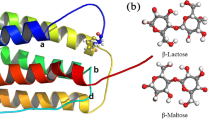Abstract
Denileukin diftitox (brand name: Ontak, DAB389IL2) is the first recombinant immunotoxin approved by FDA for treatment of CTCL (cutaneous T cell lymphoma). This smart toxin is contains truncated diphtheria toxin (DT387), genetically fused to human interleukin 2 (IL2). Like other pharmaceutical productions, there is an aggregation problem in this fusion protein production and achieving a stable protein structure is mainly recommended for clinical use. Herein, we have investigated the effects of co-solvents on the structure and function of denileukin diftitox. In this work, the histidine-tagged DAB389IL2 was expressed in Escherichia coli and after solubilizing and refolding, the inclusion body was purified using nickel chelate affinity chromatography. Then, the structural alterations of the refolded protein in the presence of different co-solvents (sorbitol, trehalose, and sucrose) were investigated using fluorescence and circular dichroism (CD) techniques. Moreover, the nuclease activity of the refolded protein was traced to confirm the refolding process,. Finally, the biological activity of produced DAB389IL2 was carried out using MTT assay. The results revealed that, DAB389IL2 is more stable in PBS including sorbitol (30 mM) than other stabilizers. The tryptophan residues flexibility—exposure of DAB389IL2 to the solvent, in the presence of sorbitol, with respect to fluorescence quenching by acrylamide, indicated the best characterization. Also, in the presence of 2 ng/ml of protease, DAB389IL2 was completely undigested and so it indicated the highly stability of the fusion protein to proteases. Furthermore, the refolding and function of the produced fusion protein is verified by DNase activity and bioassay. Therefore, the data of this research could give further insights into the protein refolding mechanism and formulation of the protein in the presence of co-solvents.






Similar content being viewed by others
References
Arakawa T, Prestrelski SJ, Kenney WC, Carpenter JF (2001) Factors affecting short-term and long-term stabilities of proteins. Adv Drug Deliv Rev 46:307–326
Chi EY, Krishnan S, Randolph TW, Carpenter JF (2003) Physical stability of proteins in aqueous solution: mechanism and driving forces in nonnative protein aggregation. Pharm Res 20:1325–1336
D’Amico S, Marx JC, Gerday C, Feller G (2003) Activity-stability relationships in extremophilic enzymes. J Biol Chem 278:7891–7896
Duvic M, Talpur R (2008) Optimizing denileukin diftitox (ontak) therapy. Future Oncol 4:457–469
Ebrahimi Bagha M, Zeinoddini M, Saeedinia AR, Xodadadi N (2018) Overexpression and purification of diphtheria fusion toxin: DAB389IL-2. J Bionanosci 12:688–693
Eklund JW, Kuzel TM (2005) Denileukin diftitox: a concise clinical review. Expert Rev Anticancer Ther 5:33–38
Figgitt DP, Lamb HM, Goa KL (2000) Denileukin diftitox. Am J Clin Dermatol 1:67–72
Foss FM (2000) DAB(389)IL-2 (denileukin diftitox, ONTAK): a new fusion protein technology. Clin Lymphoma 1:S27–S31
Frankel AE, Kreitman RJ, Sausville EA (2000) Targeted toxins. Clin Can Res 6:326–334
Frokjaer S, Otzen DE (2005) Protein drug stability: a formulation challenge. Nat Rev Drug Discov 4:298–306
Howman RA, Prince HM (2011) New drug therapies in peripheral T-cell lymphoma. Expert Rev Anticancer Ther 11:457–472
Iyer PV, Ananthanarayan L (2008) Enzyme stability and stabilization: aqueous and non-aqueous environment. Process Biochem 43:1019–1032
Kaminetzky D, Hymes KB (2008) Denileukin diftitox for the treatment of cutaneous T-cell lymphoma. Biol Targ Thera 2:717–724
Kreitman RJ (2006) Immunotoxins for targeted cancer therapy. AAPS J 8:532–551
Lansigan F, Stearns DM, Foss F (2010) Role of denileukin diftitox in the treatment of persistent or recurrent cutaneous T-cell lymphoma. Cancer Manag Res 2:53–59
Li YM, Hall WA (2010) Targeted toxins in brain tumor therapy. Toxins 2:2645–2662
Manoukian G, Hagemeister F (2009) Denileukin diftitox: a novel immunotoxin. Expert Opin Biol Ther 9:1445–1451
Moghaddas M, Zeinoddini M, Saeedinia AR, Bayat S (2018) Structural and functional assessment of diphtheria fusion toxin: DT389GCSF. J Bionanosci 12(2):240–244
Mosmann T (1983) Rapid colorimetric assay for cellular growth and survival: application to proliferation and cytotoxcity assays. J Immunol Methods 65(1–2):55–63
Murakami S, Kinoshita M (2016) Effects of monohydric alcohols and polyols on the thermal stability of a protein. J Chem Phys 144:125105
Oshima H, Kinoshita M (2013) Effects of sugars on the thermal stability of a protein. J Chem Phys 138:245101
Pastan I, Hassan R, FitzGerald DJ, Kreitman RJ (2006) Immunotoxin therapy of cancer. Nat Rev Cancer 6:559–565
Pastan I, Hassan R, FitzGerald DJ, Kreitman RJ (2007) Immunotoxin treatment of cancer. Annu Rev Med 58:221–237
Sek DC (2008) Protein formulations containing sorbitol. US20080200655 A1
Shire SJ (2009) Formulation and manufacturability of biologics. Curr Opin Biotechnol 20:708–714
Stevenson CL (2000) Characterization of protein and peptide stability and solubility in non-aqueous solvents. Curr Pharm Biotechnol 1:165–182
Talpur R, Jones DM, Alencar AJ, Apisarnthanarax N, Herne KL, Yang Y, Duvic M (2006) CD25 expression is correlated with histological grade and response to denileukin diftitox in cutaneous T-cell lymphoma. J Invest Dermatol 126:575–583
Wang W (2005) Protein aggregation and its inhibition in biopharmaceutics. Int J Pharm 289:1–3
Weiss WF, Young TM, Roberts CJ (2009) Principles, approaches, and challenges for predicting aggregation rates and shelf life. J Pharm Sci 98(4):1246–1277
Zeinoddini M, Khajeh K, Hosseinkhani S, Saeedinia AR, Robatjazi SM (2013) Stabilisation of recombinant aequorin by polyols: activity, thermostability and limited proteolysis. Appl Biochem Biotechnol 170:273–280
Acknowledgements
This study has been supported by the Malek-Ashtar University of Technology.
Author information
Authors and Affiliations
Corresponding author
Rights and permissions
About this article
Cite this article
Bayat, S., Zeinoddini, M., Azizi, A. et al. Co-Solvents Effects on the Stability of Recombinant Immunotoxin Denileukin Diftitox: Structure and Function Assessment. Iran J Sci Technol Trans Sci 43, 2091–2097 (2019). https://doi.org/10.1007/s40995-019-00676-7
Received:
Accepted:
Published:
Issue Date:
DOI: https://doi.org/10.1007/s40995-019-00676-7




